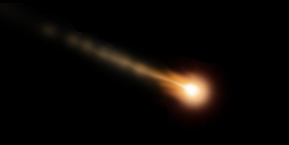
This is by no means an all-encompassing review of features to look for when you think you might have found a meteorite, but rather it is intended to cover the majority of cases as a rough guide. It is remarkable how many different types of meteorites we've already identified, and it seems like every year we discover something new. Please feel free to contact me if you have any questions, as I am always actively growing my collection through new acquisitions and can also direct you to an independent classification facility.
About 94% of all witnessed falls are NOT primarily composed of metal, so the irons and stony irons (which ARE primarily metal) are fairly rare.
Here are some basic indicators to look for if you think you've found a meteorite:
Is it "heavier than it looks?"
 In spite of the fact that the vast majority of witnessed falls are similar in appearance to terrestrial rocks, most of these contain a fairly high percentage of nickel-iron flecks which make the specimen feel heavier than it appears it should be.
In spite of the fact that the vast majority of witnessed falls are similar in appearance to terrestrial rocks, most of these contain a fairly high percentage of nickel-iron flecks which make the specimen feel heavier than it appears it should be.
Is there evidence of thumb printing on the surface?
 Thumb prints, or regmaglypts, appear on the surface of many meteorites and are caused by irregular flow of the atmosphere across the surface of the meteoriod -- or in some cases by constituent parts such as troilite (iron sulfide) burning out at lower temperatures than the matrix and forming ablation pockets in the exterior. They leave the impression that fingertips have molded the surface of the meteorite as if it were made of dough.
Thumb prints, or regmaglypts, appear on the surface of many meteorites and are caused by irregular flow of the atmosphere across the surface of the meteoriod -- or in some cases by constituent parts such as troilite (iron sulfide) burning out at lower temperatures than the matrix and forming ablation pockets in the exterior. They leave the impression that fingertips have molded the surface of the meteorite as if it were made of dough.
Does the specimen have an angular or nosecone shape?

 Fragmentation during atmospheric flight can leave sharp -- though slightly rounded at the points -- corners on the stone. Additionally, flight oriented meteorites may have a parabolic shape to the leading face coupled with a markedly different morphology on the reverse face.
Fragmentation during atmospheric flight can leave sharp -- though slightly rounded at the points -- corners on the stone. Additionally, flight oriented meteorites may have a parabolic shape to the leading face coupled with a markedly different morphology on the reverse face.
Do the exterior and interior of the stone contrast with one another in color, with the exterior appearing to have been fused or darkened?
 This is most evident in stony meteorites, and it is not uncommon to see a dark exterior fusion crust along with a lighter colored interior (when there are breaks from impact -- be careful not to severely damage the stone when looking for this feature, as a slightly ground corner is enough to make a determination).
This is most evident in stony meteorites, and it is not uncommon to see a dark exterior fusion crust along with a lighter colored interior (when there are breaks from impact -- be careful not to severely damage the stone when looking for this feature, as a slightly ground corner is enough to make a determination).
Are there signs of rust?
 About 90% of all witnessed falls contain some quantity of nickel-iron, and subjected to most terrestrial conditions will rust over time.
About 90% of all witnessed falls contain some quantity of nickel-iron, and subjected to most terrestrial conditions will rust over time.
Is there evidence of surface flow features?
 A large percentage of meteorites -- if recovered in a relatively fresh state and if their composition and flight dynamics permit -- may show physical surface evidence of molten material having been flash-frozen around the retardation point of their flight (when they lose cosmic velocity and cease to "burn").
A large percentage of meteorites -- if recovered in a relatively fresh state and if their composition and flight dynamics permit -- may show physical surface evidence of molten material having been flash-frozen around the retardation point of their flight (when they lose cosmic velocity and cease to "burn").
It is easy to be fooled!
 Whatever you do in the process of investigating your prospective meteorite, please don't get your hopes up too early. About 1 in every 1000 specimens submitted to museums and scientific institutions actually turn out to be meteoric in nature, but at least it's not 0 out of 1000! I was all but certain that the specimen in this image was a flight oriented Martian shergottite when I first found it, but it turned out to be nothing more than a terrestrial (Earthly) basalt.
Whatever you do in the process of investigating your prospective meteorite, please don't get your hopes up too early. About 1 in every 1000 specimens submitted to museums and scientific institutions actually turn out to be meteoric in nature, but at least it's not 0 out of 1000! I was all but certain that the specimen in this image was a flight oriented Martian shergottite when I first found it, but it turned out to be nothing more than a terrestrial (Earthly) basalt.
 About
About Priorities
Priorities Meteorites 101
Meteorites 101 Logo Merchandise
Logo Merchandise

